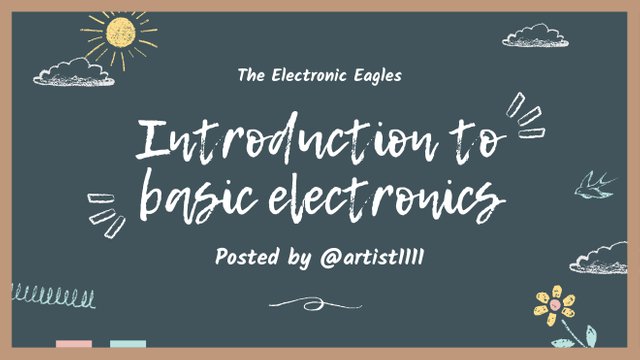
Hello, everyone! Today, I am here to present my assignments regarding the Electronics Academy. Electronics is an extremely interesting branch of Physics and Engineering related to lower voltages and intensities, due to semiconductor elements.
In our first lesson, we learned the basic components together with their symbols. We have worked on the symbols for connected and not-connected wires, then the plus and minus terminals. Attached to this workshop 1, I have drawn various component symbols such as a resistor, diodes, and capacitors, among others.
In Workshop 2, I have defined important terms like Alternating Voltage and Transistors. Next, Workshop 3 has the identification of numerous resistors, capacitors, and more. Last but not least identification of various components .
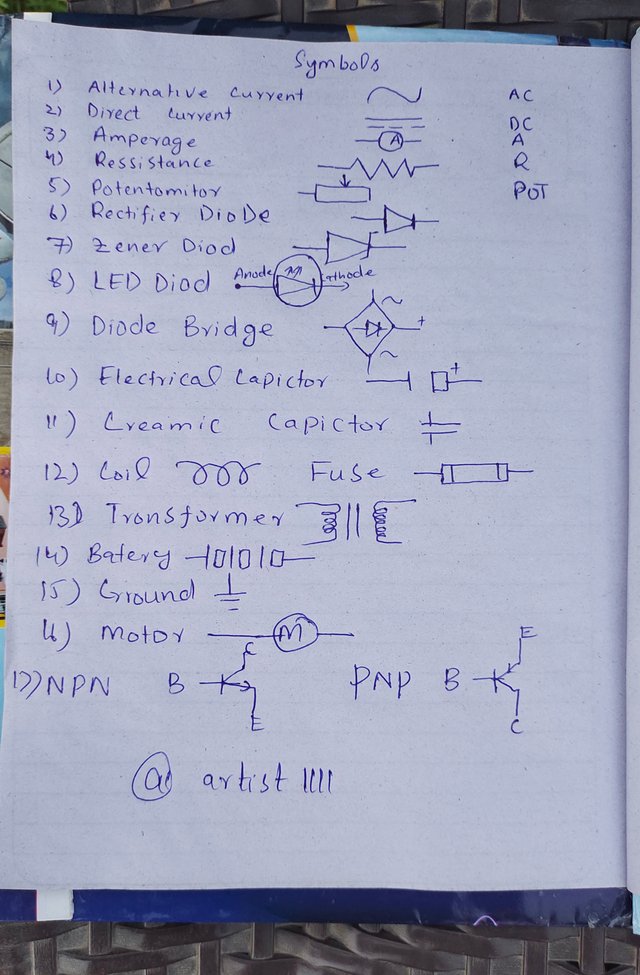
Workshop 2 |
|---|
Definitions
| Term | Explanation |
|---|---|
| Alternating Voltage | Voltage that periodically reverses direction, commonly used in household power supplies. |
| Direct Voltage | Voltage that flows in one only direction, typically used in batteries & DC power supplies. |
| Resistance | A measure of the opposition to the flow of current in an electrical circuit, its measured in ohms (Ω). |
| Potentiometer | A variable resistor used to adjust voltage and current in a circuit. |
| Rectifier Diode | A semiconductor device that allows the current to flow in one direction only, converting AC to DC. |
| Diode Bridge | An arrangement of diodes connected in a diamond configuration that provides the same polarity of output for either polarity of input. |
| Capacitor | It is an electronic device that stores electrical energy in an electric field. The device is majorly used to smooth out voltage fluctuations, but finds its best application in filtering. |
| Transistor | A semiconductor device used for the amplification of or switching electronic signals and electrical power. |
| Transformer | A device making use of electromagnetic induction to transfer electrical energy between two circuits or more, aims at increasing or decreasing the voltage of AC. |
| Fuse | A protective device that melts and breaks the circuit under excessive currents to safeguard electrical circuits. |
| Lithium Battery | A rechargeable battery that takes lithium ions as the key component of their electrolyte, with features of high energy density and a long cycle life. |
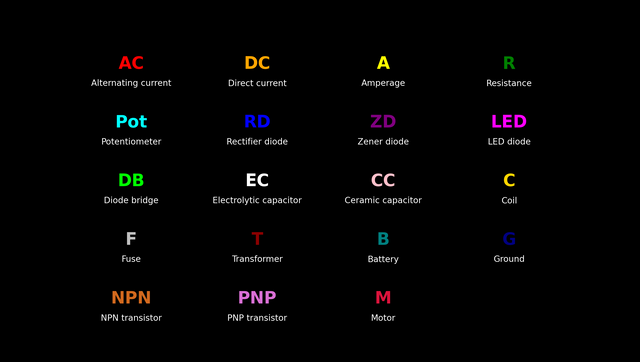 Denoted by Denoted by |
|---|
Workshop 3: |
|---|
Types of Components
| Resistors |
|---|
| Fixed resistor: whose value does not change. |
| Variable resistor: whose value can be changed. |
| Capacitors |
|---|
| Electrolytic capacitor: used for high capacitance values. |
| Ceramic capacitor: used for lower capacitance values and high-frequency applications. |
| Diodes |
|---|
| Rectifier diode: converts AC to DC. |
| Zener diode: allows current to flow in the reverse direction when a specific voltage is reached. |
| Transistors |
|---|
| NPN transistor: a type of bipolar junction transistor with one p-type layer sandwiched between two n-type layers. |
| PNP transistor: a type of bipolar junction transistor with one n-type layer sandwiched between two p-type layers. |
| Coils |
|---|
| Inductor coil: stores energy in a magnetic field when electrical current passes through it. |
| Toroidal coil: a donut-shaped inductor with improved efficiency and reduced electromagnetic interference. |
Workshop 4 |
|---|
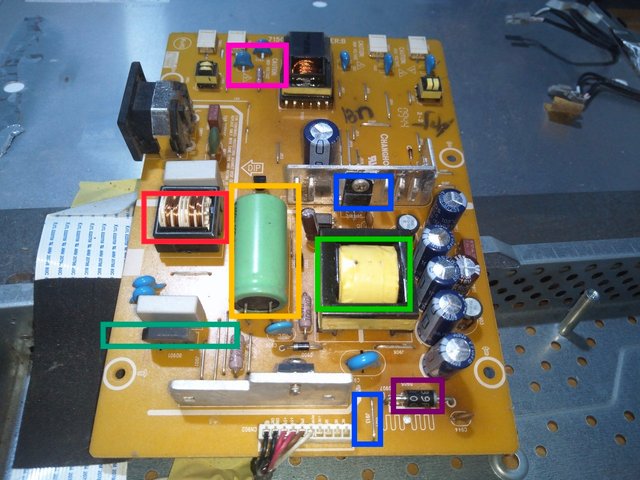
Here's the identification of the electronic components on the circuit board, color-coded as in the image:
Transformer:
- Green Color Box: The yellow component with black edges in the green box is a transformer. It is used to transfer electrical energy between two or more circuits through electromagnetic induction.
Inductor:
- Red Color Box: The component with copper coils in the red box is an inductor. It stores energy in a magnetic field when electrical current flows through it.
Capacitor:
- Yellow Color Box: The green cylindrical component in the yellow box is an electrolytic capacitor. It stores electrical energy temporarily and is used in power supply circuits to smooth out voltage fluctuations.
Diode:
- Light Green Color Box: The small black component in the light green box is a diode. It allows current to flow in one direction only and is used for rectification.
Transistor:
- Dark Blue Color Box: The small black component with three leads in the dark blue boxes are transistors. They are used to amplify or switch electronic signals.
Fuse:
- Magenta Color Box: The small blue cylindrical component in the magenta box is a fuse. It protects the circuit by breaking the connection if the current exceeds a certain level.
IC (Integrated Circuit):
- Purple Color Box: The component in the purple box with multiple legs is an integrated circuit. It contains multiple electronic components such as transistors, resistors, and capacitors in a single package.
Each of these components plays a crucial role in the functionality of the circuit.
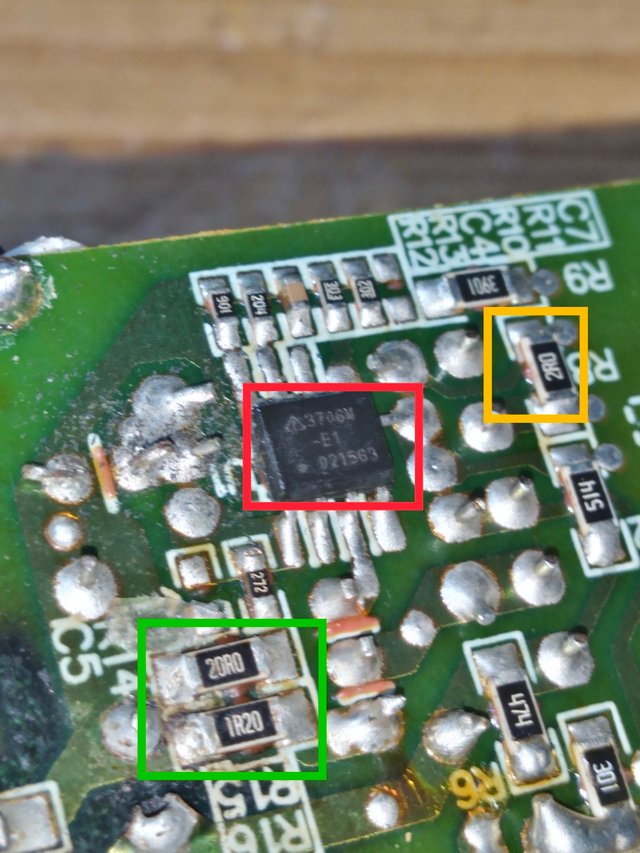
Take a look in this image ,
- Yellow Color Box:
- Component: Resistor
- Explanation: The component in the yellow box is a surface-mount resistor. The marking "2R0" indicates its resistance value is 2 ohms. Resistors like these are used to limit current flow, divide voltages, and dissipate power in electrical circuits.
- Red Color Box:
- Component: Integrated Circuit (IC)
- Explanation: The component in the red box is an integrated circuit. ICs have a number of electronic elements—transistors, resistors, capacitors—put together in one package and can implement many functions depending upon their design. Specifically, the IC shown in this figure will also perform the operation related to signal processing or control in the circuit.
- Green Color Box:
- Component: Surface-Mount Resistors
- Description: The components in the green box are surface-mount resistors. Markings on these two resistors, "20R0" and "1R20," provide the resistance value for each: 20 ohms and 1.2 ohms, respectively. These resistors will be present in current limiting and voltage division in a circuit.
There is an important contribution from each of these components toward the functionality and stability of an electronic circuit.
Finally, I would like to extend an invitation to a few friends to participate in this contest if they haven't already. I encourage @harferri, @shahid76, and @saintkelin76 to share their entries.
kind Regards
@artist1111

Adieu, folks!
May the winds of fortune
carry you to greatness!
May the winds of fortune
carry you to greatness!
Taller 1: Ha representado todos los componentes solicitados, excepto el fusible que dibujó el componente. Debe revisar bien ese símbolo ya que no se representa así en un diagrama.
Taller 2: Ha definido en forma clara, y concreta la asignación.
Taller 3: Has mencionado una cantidad limitada de tipos de componentes, trate de estudiar más sobre los tipos de componentes señalados para que pueda avanzar en las siguientes lecciones.
Tarea 4: Ha identificado una moderada cantidad de componentes en la tarjeta, su forma de identificar me precio un poco confusa porque se debe bajar y subir para ver qué componente está describiendo.
En la tarjeta smd ha identificado y descrito los componentes señalados, aunque no observó uno más.
No mostró una tarjeta de su parte para identificar elementos. No está del todo completa.
Comment/Recommendation
Trate de completar todas las tareas para poder obtener mejores calificaciones.
Scores| 6.5/10
Downvoting a post can decrease pending rewards and make it less visible. Common reasons:
Submit
Thank you my friend for your feedback and suggestion 😊
Downvoting a post can decrease pending rewards and make it less visible. Common reasons:
Submit
Upvoted. Thank You for sending some of your rewards to @null. It will make Steem stronger.
Downvoting a post can decrease pending rewards and make it less visible. Common reasons:
Submit